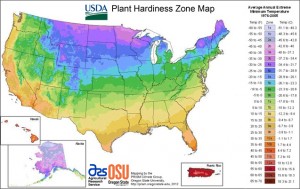 If you live in a cold area, you’re likely familiar with the most common struggles that come with gardening in these climates. With a few careful considerations, you can turn the cold weather into your best gardening ally. Below, we’ll tell you how to choose the best plants for your climate and successfully protect them from the cold all Fall and Winter long.
If you live in a cold area, you’re likely familiar with the most common struggles that come with gardening in these climates. With a few careful considerations, you can turn the cold weather into your best gardening ally. Below, we’ll tell you how to choose the best plants for your climate and successfully protect them from the cold all Fall and Winter long.
Find Your Zone: When you know your hardiness zone, you can make a more informed choice when choosing your plants. The hardiness zones range from 1 (coldest) to 13 (warmest). Choose plants that thrive specifically in your zone, or you may be doomed from the start. You can find your Hardiness Zone by entering your zip code here: http://planthardiness.ars.usda.gov/PHZMWeb/.
Choose the right plants: While many plants and vegetables do well in warmer climates, there are several fruits and vegetables that will only thrive in colder climates and can even be planted outside of spring. Here are some of the most popular:
 Leafy Greens: Leafy greens like lettuce, cabbage and spinach grow very well in cool climates. You can toss them into anything, so you won’t have to struggle to get through these after harvesting.
Leafy Greens: Leafy greens like lettuce, cabbage and spinach grow very well in cool climates. You can toss them into anything, so you won’t have to struggle to get through these after harvesting.
Carrots: Carrots become sweeter as the temperature cools. They are best harvested through the late fall and into early winter.
Blueberries: According to gardeningchannel.com, “Blueberry bushes like very acidic soil, and will grow in soils that are downright inhospitable to other plants. Sandy, acidic soils in a pH range of 4.0 to 5.0 are best.”
Broccoli: Broccoli loves cool weather, rich soil, and full sun. It grows best when planted from a transplant, at 4-6 weeks.
Don’t Plant Too Early: While it may feel warm enough to plant by May or even April, most cold climates are still at risk for frost formation until the first week in June. Take your time and wait until the coast is clear. This will help you get the most out of your plants, as most will be killed entirely by frost.
Insulate: A layer of mulch on top of the soil for insulation will help to protect vegetables against cold temperatures by keeping roots warm. Two inches worth of mulch is often a safe enough blanket for your plants. The mulch will also help to prevent weeds and keep pests away, especially once it’s cold.
Here are some other great resources for cold weather gardening:
https://www.facebook.com/ColdClimateGardening
Related post:




